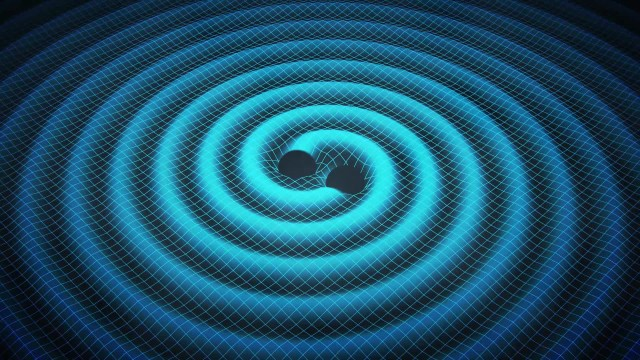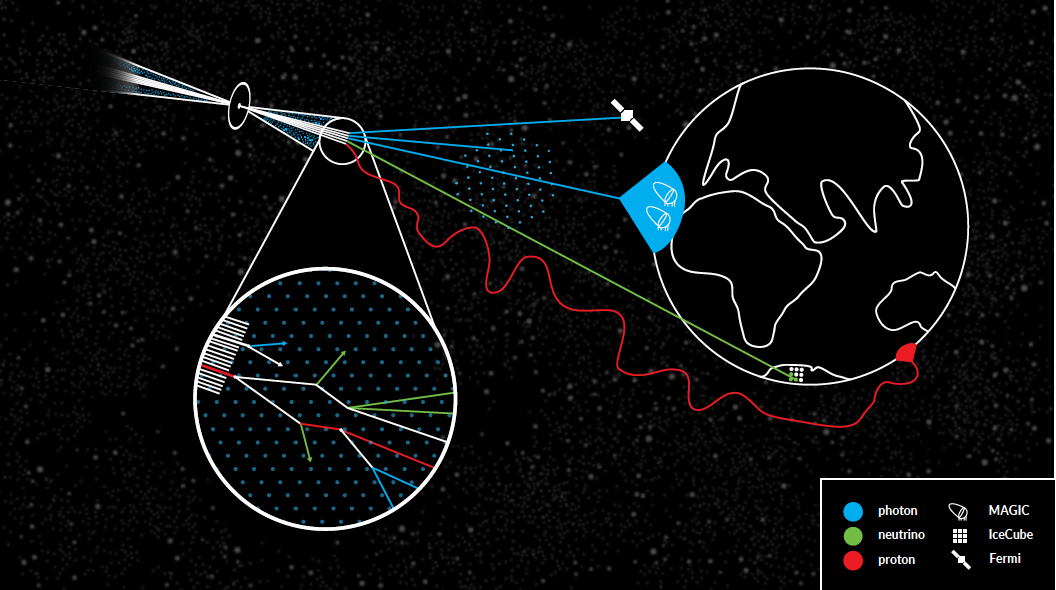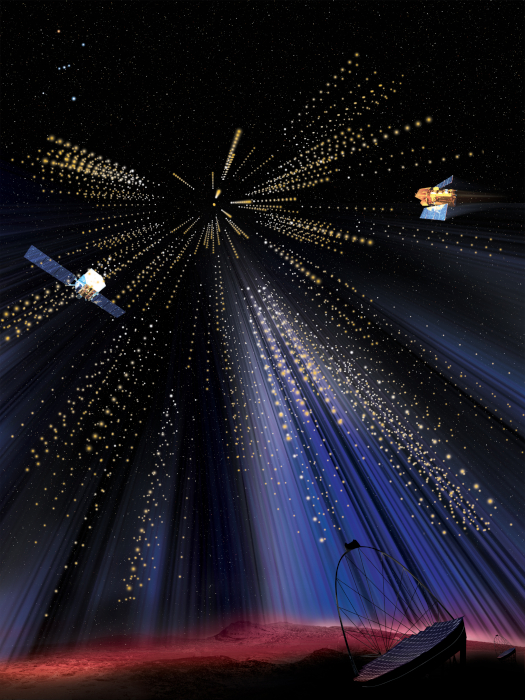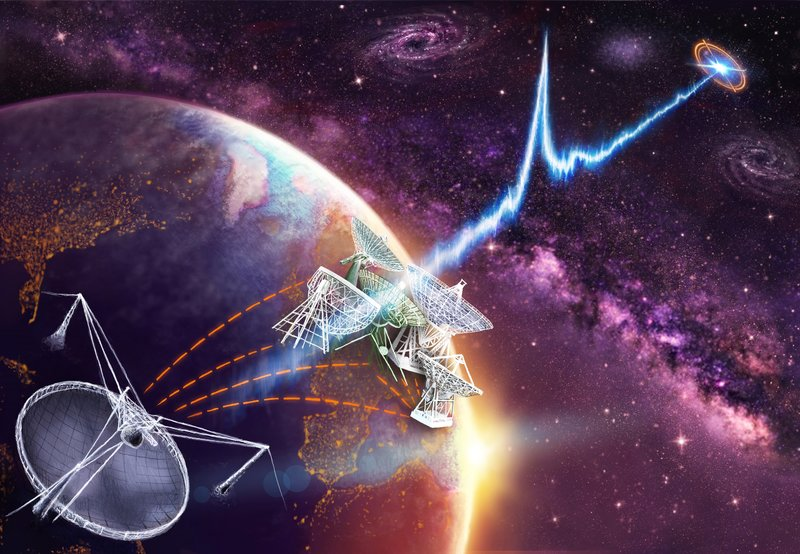MAGIC
Skip navigation and go to main content
- Home
- General Information
- Science with MAGIC
- MAGIC members
- Maintenance
Transient Phenomena
The Universe is full of fascinating phenomena whose duration varies from secular to millisecond scales. Some of them we know since centuries, some of them we only became aware of recently, thanks to new developments in instrumentation and analysis techniques. Those developments allow us to catch signals conveyed by many different messengers such as photons of the highest energies, neutrinos, cosmic rays or gravitational waves. Although we receive those signals we do not fully understand their origins and the underlying emission mechanisms. Theoretical models often predict that the same objects should emit not only photons, along a broad range of the electromagnetic spectrum, but also other particles. Nevertheless, although we identified several classes of very high energy (VHE) gamma-ray emitters, the sources of neutrinos and cosmic rays still elude us. Numerous explanations were proposed and many of them postulate transient phenomena, most of which are very poorly understood, especially in the very high energy regime.
The Transients Working Group in MAGIC aims at conducting rapid follow-up observations in response to alerts for new transient objects and multi-messenger signals, in order to identify their origin and explore the relevant physics. Key targets include gamma-ray bursts (GRBs), fast radio bursts (FRBs), tidal disruption events (TDEs), high-energy neutrino alerts and gravitational wave (GW) alerts.
Gravitational Wave Alerts
GWs were detected in the past years by the Laser Interferometric detectors LIGO and Virgo mostly from binary black hole merger events but also from a binary neutron star system in the case of GW 170817. Especially those from compact binary mergers involving neutron stars may be accompanied by VHE emission. The first two science runs (O1, O2) of the LIGO Scientific Collaboration and Virgo Collaboration (LVC) have been astonishing, providing some of the most exciting scientific discoveries of the decade. During O1 the era of GW astronomy was opened with the first ever direct detection of gravitational waves from the coalescence of binary systems formed by two stellar mass black holes (BH). O2 was even more successful with more BH/BH system detections and the first gravitational signal received from the coalescence of two neutron stars (NS, GW170817). The event was also almost simultaneously detected as a weak short gamma-ray burst by the Fermi and Integral satellites. The rapid discovery of the optical counterpart allowed an impressive follow-up campaign. The source turned out to be a long-sought macronova/kilonova, i.e. an almost isotropic optical and NIR source powered by the decay of radioactive nuclei generated by r-process nucleosynthesis.
Electromagnetic signatures were indeed expected from BNS mergers, due to energetic matter outflows at different timescales and wavelengths and the results of the observations showed again an excellent general agreement with the theoretical predictions. It is therefore clear that observing the electromagnetic (EM) counterparts of a GW signals is becoming one of the major goals of astronomy for the near future: EM counterparts play a key role in localizing the GW source, in establishing the properties of the environment of the binary system, and in finding the association to cosmic phenomena. The EM and GW signals are essentially complementary in understanding the progenitor. MAGIC follow-up observations of GW alerts can potentially provide improved detection significance and source localization, as well as crucial insight into the physics of the merger event. MAGIC is following the alerts provided by LIGO/Virgo in the Northern sky aiming to discover a VHE counterpart of the GW events.

High-Energy Neutrino Alerts
The recent observation of an astrophysical flux of high-energy neutrinos by the IceCube detector is a tantalising clue in finding the long-sought sources of cosmic rays and a hint of hadronic interactions at cosmic-ray accelerators. Transient sources as origins of neutrino events gained increasing attention. MAGIC exploits the possibility to search for transient neutrino sources, following the neutrino alerts from IceCube. This allows to search for hadronic gamma-ray emission from the directions of neutrino alerts.
In September 2017, blazar TXS 0506+056 (R.A.: 05:09:25, Dec.: +05:42:09 (J2000), redshift z=0.3365) was detected in an enhanced gamma-ray emission state in coincidence with a very high energy (~300 TeV) neutrino event from IceCube, IC-170922A (Science 361, eaat1378 (2018)). The MAGIC telescopes, thanks to their high sensitivity and persistent observation plan, were the first instruments to discover TXS 0506+056 in very high energy gamma-rays (VHE, E >100 GeV). This is, by far, the most significant association between a high-energy neutrino from IceCube and an astrophysical source emitting gamma rays. TXS 0506+056 became a key object to help the astrophysics community to establish connections between high-energy neutrinos and astrophysical sources.
The source lies in the sky region where the IceCube neutrino observatory is most sensitive. Recent results from the IceCube 10 years analysis place this source as one of the most significant neutrino ''hot-spots'' in the northern hemisphere. What is more a neutrino flare was observed from this source in the years 2014-15, unfortunately with very sparse electromagnetic coverage (IC Collaboration, Science (2018)).
The quasi-simultaneous neutrino and broadband electromagnetic triggered by the IC-170922A event were interpreted with a lepto-hadronic model, based on interactions of electrons and protons co-accelerated in the jet with external photons. The modeling confirmed that this source could be a potential cosmic ray and neutrino emitter, even if the emission in the electromagnetic band seems to be mostly leptonic (MAGIC Collaboration, Ansoldi et al., (2018)).
Animation is available here
 Credit: W. Racz, I. Rams (PJWSTK), E.Bernardini, K.Satalecka (DESY)
Credit: W. Racz, I. Rams (PJWSTK), E.Bernardini, K.Satalecka (DESY)
Gamma-ray Bursts
GRBs are extremely luminous explosions that occur at cosmological distances, approximately once per day. They are thought to be triggered by a particular type of stellar collapses (long GRBs) or merger events involving neutron stars and/or black holes (short GRBs). They were discovered by chance at the end of the 1960s by satellites used to monitor compliance with the nuclear test ban on Earth.
Despite almost 50 years of research since GRB discovery, many basic aspects of their nature remain poorly understood. VHE gamma-ray observations of GRBs address key questions including the physical mechanisms of the GRB prompt emission and early afterglow, and the potential production of ultra-high-energy cosmic rays and high-energy neutrinos.
GRBs also serve as important probes for observational cosmology (high-redshift extragalactic background light and intergalactic magnetic fields, see here ) and fundamental physics (Lorentz invariance violation, see here ).
The search for potential VHE emission from GRBs started long before high energy photons at energies below 100 GeV were detected by Fermi-LAT, but no significant signal could be detected. The MAGIC project was conceived with GRBs observations as one of the highest scientific priorities. The telescopes were designed with a light structure which enables fast repointing (only 25s to reach any point in the visible sky), crucial for catching the prompt and early afterglow emission of GRBs.
On 14 January 2019 the Swift-BAT and Fermi-GBM instruments detected the long GRB 190114C. An alert reporting the coordinates of the event was sent automatically to the astrophysical community after 22 seconds from the initial detection and received by the MAGIC telescopes. MAGIC slewed and pointed the sky position of the GRB in about 30 seconds after the alert, starting observations only 57 seconds after the Swift trigger. The follow-up of GRB 190114C resulted in the detection of about thousand of gamma rays with energies from 0.2 to 1 TeV in the GRB afterglow, with a strong VHE signal lasting almost 40 minutes. These are by far the highest energy photons detected from a GRB and the resulting gamma-ray flux in the first tens of seconds makes GRB 190114C the brightest VHE source at 0.3 TeV.
MAGIC quickly alerted the astrophysical community of the discovery, allowing more that twenty observatories and instruments to perform a follow-up of the GRB at different wavelengths. The data collected by MAGIC and multi-wavelength partners were fundamental to understand that the process producing VHE gamma rays is not synchrotron radiation, which is thought to be responsible for the afterglow emission at lower energies. The physical mechanisms underlying the VHE emission is a different process and the data modeling suggests that the most feasible candidate is the so-called synchrotron-self Compton. In such mechanism, photons produced via synchrotron radiation by energetic electrons are boosted in energy by scattering with their parent electrons, reaching the energies detected by MAGIC.
The result achieved by MAGIC proved for the first time the feasibility of the detection of VHE emission from GRBs with Cherenkov telescopes and boosted our knowledge of GRB physics in the afterglow. Future searches with MAGIC will focus on detecting more GRBs in the afterglow and possibly in the prompt phase, providing crucial information on its origin, which is still unclear.
A video explaining the discovery is available here

Credit: NASA/Fermi and Aurore Simonnet, Sonoma State University.
Fast Radio Bursts
Fast radio bursts (FRBs) are bright flashes observed typically at GHz frequencies with millisecond duration, whose origin is likely extragalactic. Their nature remains mysterious, motivating searches for counterparts at other wavelengths. FRB 121102 is so far the only source known to repeatedly emit FRBs and is associated with a host galaxy at redshift z≃0.193. We conducted simultaneous observations of the FRB 121102 with the Arecibo and MAGIC telescopes during several epochs in 2016--2017. This allowed searches for millisecond-timescale burst emission in very-high-energy (VHE) gamma rays as well as the optical band. While a total of five FRBs were detected during these observations, no VHE emission was detected, neither of a persistent nature nor burst-like associated with the FRBs.
MAGIC is observing the repeating FRB 121102 within a multiwavelenght campaign including primarily the Arecibo telescope and the Veritas telescope.
In the near future, MAGIC will participate to multiwavelength campaigns on other repeating FRBs detected by instruments like CHIME and other SKA Pathfinders.

Credit: Max Planck Institut für Radioastronomie - Max-Planck-Gesellschaft.